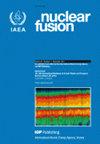DIII-D 高βN 等离子体中 RWM 稳定性的验证研究
IF 4
1区 物理与天体物理
Q1 PHYSICS, FLUIDS & PLASMAS
引用次数: 0
摘要
利用 MARS-F(Liu 等人,2000 年,物理等离子体 7 3681)和 MARS-K(Liu 等人,2008 年,物理等离子体 15 112503)代码,对 176440 和 172461 两个 DIII-D 高βN 放电的 n = 1(n 为环模数)电阻壁模(RWM)稳定性进行了数值研究。我们首次尝试对大部分等离子体体积的环形流非常缓慢或消失的放电进行系统验证。在这些慢速旋转实验中,我们获得了在βN超过特洛伊翁无壁极限时进入稳定运行机制的物理学见解,同时进一步证实了流体和非微扰磁流体动力学-动力学混合模型对 RWM 的预测能力。MARS-F 流体模型具有模仿平行声波的离子朗道阻尼的强大但数值可调的粘度,它发现在实验流动条件下,n = 1 RWM 在所考虑的 DIII-D 等离子体中完全稳定。同样,MARS-K 混合模型也计算出了该模式的完全稳定(对于放电 176440)或边缘稳定(对于放电 172461),该模型基于第一原理,没有自由模型参数。特别是,所有漂移动能共振,包括热粒子和高能粒子的漂移动能共振,都会协同作用,使放电 172461 中的 RWM 稍微稳定。这些 MARS-F/K 建模结果解释了实验观测到的 DIII-D 稳定运行机制,即 RWM 的稳定性。为了进一步支持验证研究,还对等离子体环流速度和阻力壁的径向位置进行了广泛的数值敏感性研究。本文章由计算机程序翻译,如有差异,请以英文原文为准。
Validation study of RWM stability in DIII-D high-βN plasmas
The n = 1 (n is the toroidal mode number) resistive wall mode (RWM) stability is numerically investigated for two DIII-D high-β N discharges 176440 and 172461, utilizing the MARS-F (Liu et al 2000 Phys. Plasmas 7 3681) and MARS-K (Liu et al 2008 Phys. Plasmas 15 112503) codes. Systematic validation efforts are attempted, for the first time, for discharges with very slow or vanishing toroidal flow for a large fraction of the plasma volume. While gaining physics insights in accessing stable operation regime at β N exceeding the Troyon no-wall limit in these slow-rotation experiments, the predictive capability of fluid and non-perturbative magnetohydrodynamic-kinetic hybrid models for the RWM is further confirmed. The MARS-F fluid model, with a strong but numerically tunable viscosity mimicking ion Landau damping of parallel sound waves, finds complete stabilization of the n = 1 RWM in the considered DIII-D plasmas under the experimental flow conditions. Similarly, either full stabilization (for discharge 176440) or marginal stability (for discharge 172461) of the mode is computed by the MARS-K hybrid model, which is first-principle based without free model parameters. In particular, all drift kinetic resonances, including those of thermal and energetic particles, are found to synergistically act to marginally stabilize the RWM in discharge 172461. These MARS-F/K modeling results explain the experimentally observed stable operational regime in DIII-D, as far as the RWM stability is concerned. Extensive numerical sensitivity studies, with respect to the plasma toroidal flow speed as well as the radial location of the resistive wall, are also carried out to further support the validation study.
求助全文
通过发布文献求助,成功后即可免费获取论文全文。
去求助
来源期刊

Nuclear Fusion
物理-物理:核物理
CiteScore
6.30
自引率
39.40%
发文量
411
审稿时长
2.6 months
期刊介绍:
Nuclear Fusion publishes articles making significant advances to the field of controlled thermonuclear fusion. The journal scope includes:
-the production, heating and confinement of high temperature plasmas;
-the physical properties of such plasmas;
-the experimental or theoretical methods of exploring or explaining them;
-fusion reactor physics;
-reactor concepts; and
-fusion technologies.
The journal has a dedicated Associate Editor for inertial confinement fusion.
 求助内容:
求助内容: 应助结果提醒方式:
应助结果提醒方式:


